Funny Merlin Wallpaper Does No Approve
Army of Darkness , titled on-screen as Bruce Campbell vs. Army of Darkness (also known as Evil Dead III: The Medieval Dead and Evil Dead 3: Army of Darkness ) is a 1992 comedic, dark fantasy-adventure film. A sequel to The Evil Dead and Evil Dead II, Army of Darkness was again directed by Sam Raimi, written by Raimi and his brother Ivan, produced by Robert Tapert, and Bruce Campbell who also stars. Despite being a sequel to the two Evil Dead films, it is not as violent or gory, relying more on slapstick and Black Comedy.
The movie had a considerably higher budget than the prior two Evil Dead films, estimated to be around $11 million, whereas Evil Dead II had a budget of $3.5 million and The Evil Dead a budget of $350,000. At the box office, Army of Darkness was not a big success, barely making back its budget with a gross of $11.5 million domestically. After its video release, however, it has obtained an ever-growing cult following, along with the other two films in the trilogy
Plot
Picking up where Evil Dead II left off, Ash narrates how he and his girlfriend Linda (played by Bridget Fonda in a very brief cameo), both supermarket clerks at an S-Mart retail store, went for a vacation in the woods to an old cabin and they discovered the book Necronomicon Ex-Mortis, or "Book of the Dead" and upon reading it, unleashed demonic forces as detailed in the previous films The Evil Dead and Evil Dead II. After reading a spell to defeat the demons, Ash is sucked into a time vortex with his Oldsmobile and is transported back to AD 1300 ("As near as I can figure").
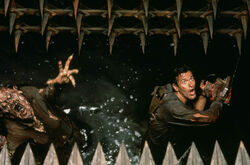
Ash faces the Pit Bitch.
There are some differences between the ending of Evil Dead II and the beginning of Army of Darkness. In this movie, instead of being praised, Ash is at first suspected of being one of Duke Henry's men, a Scot at war with the English knights who found Ash. He is enslaved, his gun and chainsaw confiscated, and is taken to a castle. A Priest keeps Ash's weapons, believing the "strange one" to be a redeemer, foretold in prophecy to be the one who shall deliver mankind from the terror of the Deadites. Ash is thrown in a pit where he fights off a Deadite, regains his weapons, and uses his "boomstick", a Remington double-barreled sawed-off shotgun, to frighten the inhabitants of the kingdom into helping him return to his own time.
The only way to return to his time and stop the Deadites, according to the priest who gave Ash back his weapons, is to retrieve the Necronomicon - which contains both spells. Ash is supposed to speak a mysterious phrase when he takes the Necronomicon, "Klaatu Varata Nicto" (a nod to the film The Day the Earth Stood Still). While preparing for this, Ash becomes romantically involved with a local woman, Sheila.
Ash then journeys for the Necronomicon, along the way passing into a haunted forest. The Kandarian demon(the camera presenting its point of view) pursues Ash through the woods. Fleeing, Ash ducks into a windmill for safety. That night, he crashes into a mirror when he notices his reflection looking back at him. The small reflections of Ash climb out from the shattered mirror and torture him. After knocking him unconscious and tying him down, one of the little Ashes dives down his throat. Ash attempts to kill the little Ash by drinking boiling water, but before any effect can be assumed, "Evil Ash" begins to split off from his right shoulder. Ash panics and runs back out through the woods, where Evil Ash completely splits off of him. Ash shoots Evil Ash in the face, slices him to bits with his chainsaw, and buries him.
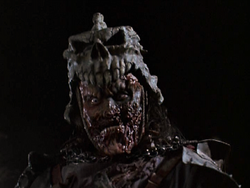
Evil Ash
When he arrives at the book's location, he sees three books instead of one. After a painful experience with the two fake books (the first one sucked him into the book and the second bit him), Ash finds the real one. He attempts to say the magic phrase, but realizes he forgot the end of it. Ash tries to trick the book by mumbling the missing word, but that re-releases the demons. He simply grabs the book and rushes back to the castle, while the dead rise from graves all around. During Ash's panicked ride back, Evil Ash rises from his grave and unites the Deadites into the Army of Darkness.
Despite causing the predicament faced by the Medieval humans, Ash initially demands to be returned to his own time. Sheila is captured by a flying Deadite, and Ash becomes determined to lead the humans against the skeletal Deadite army. Reluctantly, the people agree to join Ash. Using scientific knowledge from textbooks in the trunk of his Oldsmobile, plus enlisting the help of Duke Henry (whom Ash saved after his conflict in the pit), Ash successfully leads the humans to defeat the Deadites and save Sheila. After this, he is brought back to his own time using a potion made from the book.
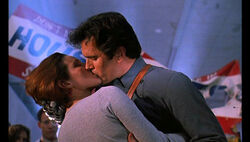
Hail To The King Baby
The final scene begins with Ash back at the S-Mart store, telling a co-worker all about his adventure back in time, and how he could have been king. After this, a deadite starts wreaking havoc on the store, and Ash defeats it. The film ends with Ash saying, "Hail to the king, baby", and kissing his fellow Sales Lady.
Production
Plans to make a third Evil Dead film had been circulating for a number of years, even prior to the production of Darkman.[1] Evil Dead II made enough money internationally that Dino De Laurentiis was willing to finance a sequel.[1] Director and script writer Sam Raimi drew from a variety of sources, including literature with A Connecticut Yankee in King Arthur's Court and Jonathan Swift's Gulliver's Travels and films like The Seventh Voyage of Sinbad, Jason and the Argonauts, and The Three Stooges. Evil Dead II, according to Bruce Campbell, "was originally designed to go back into the past to 1300, but we couldn't muster it at the time, so we decided to make an interim version, not knowing if the 1300 story would ever get made".[2] Promotional drawings were created and published in Variety during the casting process before the budget was deemed too little for the plot. The working title for the project was Evil Dead II: Army of Darkness.[3] The title "Army of Darkness" came from an idea by Irvin Shapiro, during the production of Evil Dead II.[4]
Screenplay & pre-production
Initially, Raimi invited Scott Spiegel to co-write Army of Darkness because he had done a good job on Evil Dead II, but he was busy on rewrites for the Clint Eastwood film, The Rookie.[5] After the good experience of writing the screenplay for a film called Easy Wheels, Sam and his brother Ivan Raimi decided to co-write the film together.[6] They worked on the script throughout the pre-production and production of Darkman.[1] After filming Darkman, they took the script out and worked on it in more detail. Raimi says that Ivan "has a good sense of character" and that he brought more comedy into the script.[6] Campbell remembers, "We all decided, 'Get him out of the cabin.' There were earlier drafts where part three still took place there, but we thought, 'Well, we all know that cabin, it's time to move on.' The three of us decided to keep it in 1300, because it's more interesting".[2] Campbell and Tapert would read the script drafts, give Raimi their notes and he would decide which suggestions to keep and which ones to discard.[7]
The initial budget was $8 million but during pre-production, it became obvious that this was not going to be enough.[1] Darkman was also a financial success and De Laurentiis had multi-picture deal with Universal and so Army of Darkness became one of the films. The studio decided to contribute half of the film's $12 million budget.[8] However, the film's ambitious scope and its extensive effects work forced Campbell, Raimi, and producer Rob Tapert to put up $1 million of their collective salaries to shoot a new ending and not film a scene where a possessed woman pushes down some giant pillars.[1] Visual effects supervisor William Mesa showed Raimi storyboards he had from Victor Fleming's film Joan of Arc that depicted huge battle scenes and he picked out 25 shots to use in Army of Darkness.[9] A storyboard artist worked closely with the director in order to blend the shots from the Joan of Arc storyboards with the battle scenes in his film.[9]
Principal photography
Principal photography took place between soundstage and on-location work. Army of Darkness was filmed in Bronson Canyon and Vasquez Rocks Natural Area Park] The interior shots were filmed on an Introvision stage in Hollywood. Raimi's use of the Introvision process was a tribute to the stop-motion animation work of Ray Harryhausen.[9] Introvision uses front-projected images with live actors instead of the traditional rear projection that Harryhausen and others used. Introvision blended components with more realistic-looking results. To achieve this effect, Raimi used 60-foot-tall Scotchlite front-projection screens, miniatures, and background plates.[9] According to the director, the advantage of using this technique was "the incredible amount of interaction between the background, which doesn't exist, and the foreground, which is usually your character".[10]
The shooting for Army of Darkness began in mid-1991, and it lasted for about 100 days.[11] It was a mid-summer shoot and while on location on a huge castle set that was built near Acton, California on the edge of the Mojave Desert, the cast and crew endured very hot conditions during the day and very cold temperatures at night.[12] Most of the film took place at night and the filmmakers shot most of the film during the summer when the days were longest and the nights were the shortest. It would take an hour and a half to light an area leaving the filmmakers only six hours let to shoot a scene.[13] Money problems forced cinematographer Bill Pope to shoot only for certain hours Monday through Friday because he could not be paid his standard fee. Mesa shot many of the action sequences on the weekend.[14]
It was a difficult shoot for Campbell who had to learn elaborate choreography for the battle scenes, which involved him remembering a number system because the actor was often fighting opponents that were not really there.[15] Mesa remembers, "Bruce was cussing and swearing some of the time because you had to work on the number system. Sam would tell us to make it as complicated and hard for Bruce as possible. 'Make him go through torture!' So we'd come up with these shots that were really, really difficult, and sometimes they would take thirty-seven takes".[15] Some scenes, like Evil Ash walking along the graveyard while his skeleton minions come to life, blended stop-motion animation with live skeletons that were mechanically rigged, with prosthetics and visual effects.[15]
Soundtrack
Danny Elfman, who composed the score for Darkman, wrote the "March of the Dead" theme for Army of Darkness,[16] but after the re-shoots were completed, Evil Dead II composer Joseph LoDuca returned to score the new film.[17] LoDuca sat down with Raimi and they went over the entire film, scene by scene. The composer used his knowledge of synthesizers and was able to present many cues in a mock-up form before he took them in front of an orchestra.[16]
Post-production
While Dino De Laurentiis gave Raimi and his crew freedom to shoot the movie the way they wanted, Universal Pictures took over during post-production.[18] Universal was not happy with Raimi's cut because they did not like his original ending for the movie and felt that it was "negative".[18] A more upbeat ending was shot a month after Army of Darkness was made. It was shot in a lumber store in Malibu, California over three or four nights. Then, two months after Army of Darkness was finished, a round of re-shoots began in Santa Monica and involved Ash in the windmill and the scenes with Bridget Fonda done for very little money.[18] Raimi recalls, "Actually, I kind of like the fact that there are two endings, that in one alternate universe Bruce is screwed, and in another universe he's some cheesy hero".[19]
In addition, Raimi needed $3 million to finish his movie, but Universal was not willing to give him the money and delayed its release because they were upset that De Laurentiis would not give them the rights to the Hannibal Lecter character so that they could film a sequel to |Jonathan Demme's The Silence of the Lambs.[20] The matter was finally resolved, but Army of Darkness' release date had been pushed back from its original summer of 1992 release to February 1993.
For the movie's poster, Universal brought Campbell in to take several reference head shots and asked him to strike a "sly look" on his face. They showed him a "rough of this Frank Frazetta-like painting. The actor had a day to approve it or, as he was told, there would be no ad campaign for the film.[21] Raimi ran into further troubles with the Motion Picture Association of America over the film's rating. The MPAA gave it an NC-17 rating for a shot of a female Deadite being decapitated early on in the film. Universal, however, wanted a PG-13 rating, so Raimi made a few cuts and was still stuck with the MPAA's R rating.[16] In response, Universal turned the film over to outside film editors who cut Army of Darkness to 81 minutes in length and another version running 87 minutes that was eventually released in theaters. Eventually, Army of Darkness ended up with an R rating.[16]
Reception
Box office performance
Army of Darkness was released by Universal Pictures on February 19, 1993 in 1,387 theaters in the United States, grossing $4.4 million (38.5% of total gross) on its first weekend. In total, the film earned $11.5 million in the US[22] and $21.5 million worldwide.
Critical reception
Army of Darkness was moderatly well received by critics with a 71% fresh on Rotten Tomatoes, which made its critical reception above average but is notably lower than The Evil Dead and Evil Dead II, which both received 98% critical approval. Roger Ebert gave the film two out of four stars and wrote, "The movie isn't as funny or entertaining as Evil Dead II, however, maybe because the comic approach seems recycled".[23] In her review for the New York Times, Janet Maslin praised, "Mr. Campbell's manly, mock-heroic posturing is perfectly in keeping with the director's droll outlook".[24] Desson Howe, in this review for the Washington Post praised the film's style: "Bill Pope's cinematography is gymnastic and appropriately frenetic. The visual and make-up effects (from artist-technicians William Mesa, Tony Gardner and others) are incredibly imaginative".[25] However, Entertainment Weekly gave the film a "C+" rating and wrote, "This spoofy cast of thousands looks a little too much like a crew of bland Hollywood extras. By the time Army of Darkness turns into a retread of Jason and the Argonauts, featuring an army of fighting skeletons, the film has fallen into a ditch between parody and spectacle".[26]
Awards
Army of Darkness won the Academy of Science Fiction, Fantasy & Horror Films Award (USA) for Best Horror Film (1994). It was also nominated for Best Make-Up. Army of Darkness was nominated for the Grand Prize at Avoriaz Fantastic Film Festival, and won the Golden Raven at the Brussels International Festival of Fantasy Film in 1993. The film also won the Critics' Award at Fantasporto, and was nominated for the International Fantasy Film Award in the category of Best Film in 1993.
Different versions
There are four different versions of Army Of Darkness - the 96-minute Director's Cut, the 81-minute U.S. Theatrical Version, the 88-minute International edit, and the 88-minute U.S. Television version. The Director's Cut runs at 96 minutes compared to the theatrical 81 minutes, and includes numerous new scenes and extensions. Among the changes are more violence in the pit, a love scene between Ash and Sheila, an extended windmill scene, different dialogue between Good and Bad Ash, an extended speech on the castle roof and a vastly different ending. The International cut is basically a shorter version of the Director's Cut, albeit with the "happier" ending and repositioned arrival of Henry The Red as in the theatrical version, and was the version released in cinemas outside the US. The Television edit, premiered in 1997 and most commonly shown on the Sci-Fi Channel in America, is most notable for featuring two extended scenes not included in the other three versions, though they are included in a different, rougher format in the deleted scenes section of the DVD. (In the Television version, the scenes are finished and include music.)
The theatrical release picks up after Ash has returned to the present, in which he stages one final confrontation with the "she-bitch" in the S-Mart Housewares Department. The alternate ending, which was favored by Raimi and Bruce Campbell, depicts Ash as he sits in his Oldsmobile in a cave, the entrance caved in by some of the black powder he made earlier. As he drinks the magic potion (given to him by a person that may or may not be Merlin - the king's name being "King Arthur"), he is distracted by a falling rock and takes one drop too many. Ash sleeps well beyond his time, not aging but growing a very large beard, and shouts "I've slept too long!!" after awakening in a post-apocalyptic England.
When test audiences didn't approve of Raimi's original cut, he cut the film down to the International cut that now exists on DVD. When it was again rejected by Universal, Raimi was forced to edit it again to the U.S. Theatrical version. The original cut had an opening that was more in tune with the The Evil Dead series (included as a deleted scene on Anchor Bay's Director's Cut DVD) .[27]
The MGM Hong Kong Region 3 DVD edits together the U.S. Theatrical, European and Director's cuts into a final, 96-minute cut of the film. The film is digitally re-mastered, compiled from original source prints (not from VHS sources as the Anchor Bay Entertainment releases are).[28] A new Blu Ray release of Army Of Darkness from Optimum Releasing released in the UK on September 19th 2008 contains both the cinematic and director's cut. The original VHS and DVD copies ended with the post apocalyptic ending but included the S-mart ending after the end credits. The S-mart ending provides an explanation for the various inconsistencies throughout the three films, if the entire story is being related by Ash to his co-workers he may have simplified, forgotten or glossed over some of the details (and outright lied about his mistake with the sleeping potion which transported him into the future). On October 27th, 2015, Shout! Factory, under their cult horror line "Scream Factory", released a 3-Disc Collector's Edition Blu-ray which contained all four cuts together for the first time.
Gallery
Unit still photography
Screencaps
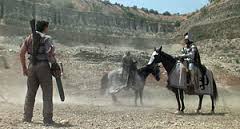
Arrival
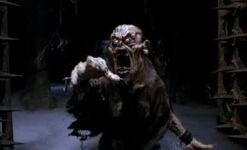
Pit Bitch
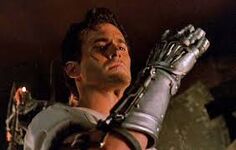
"Groovy"

"Gimme some sugar baby!"
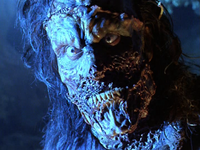
Evil Ash resurrected
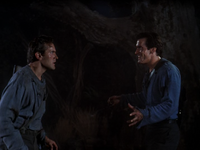
Ash and Evil Ash after they split.
Behind the scenes photos
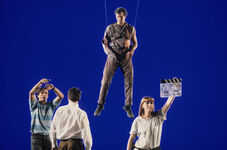
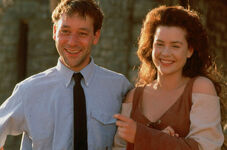
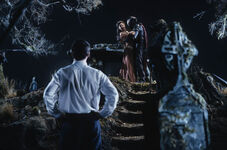
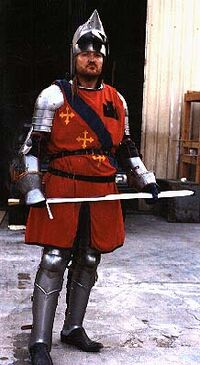

Kurzman working on the second pit bitch
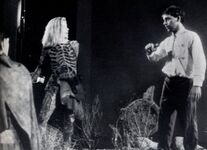
An actor without her mask
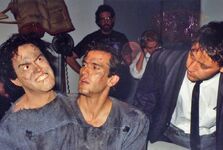
Campbell with the Stop motion puppet
References
- ↑ 1.0 1.1 1.2 1.3 1.4 Template:Cite news
- ↑ 2.0 2.1 Template:Cite news
- ↑ Warren 2000, p. 107.
- ↑ Sam Raimi. DVD audio commentary, 3:12.
- ↑ Warren 2000, p. 140.
- ↑ 6.0 6.1 Warren 2000, p. 142.
- ↑ Warren 2000, p. 145.
- ↑ Warren 2000, p. 144.
- ↑ 9.0 9.1 9.2 9.3 Muir 2004, p. 153.
- ↑ Template:Cite news
- ↑ Warren 2000, p. 147.
- ↑ Muir 2004, p. 155.
- ↑ Warren 2000, p. 151.
- ↑ Muir 2004, p. 156.
- ↑ 15.0 15.1 15.2 Muir 2004, p. 157.
- ↑ 16.0 16.1 16.2 16.3 Warren 2000, p. 153.
- ↑ Muir 2004, p. 160.
- ↑ 18.0 18.1 18.2 Muir 2004, p. 159.
- ↑ Warren 2000, p. 156.
- ↑ Muir 2004, p. 162.
- ↑ Warren 2000, p. 158.
- ↑ Template:Cite news
- ↑ Template:Cite news
- ↑ Template:Cite news
- ↑ Template:Cite news
- ↑ Template:Cite news
- ↑ Sam Raimi. DVD audio commentary.
- ↑ Rewind @ www.dvdcompare.net - Army Of Darkness AKA Evil Dead 3 AKA Army of Darkness: Evil Dead 3 (1993)
Source: https://evildead.fandom.com/wiki/Army_of_Darkness
0 Response to "Funny Merlin Wallpaper Does No Approve"
Postar um comentário